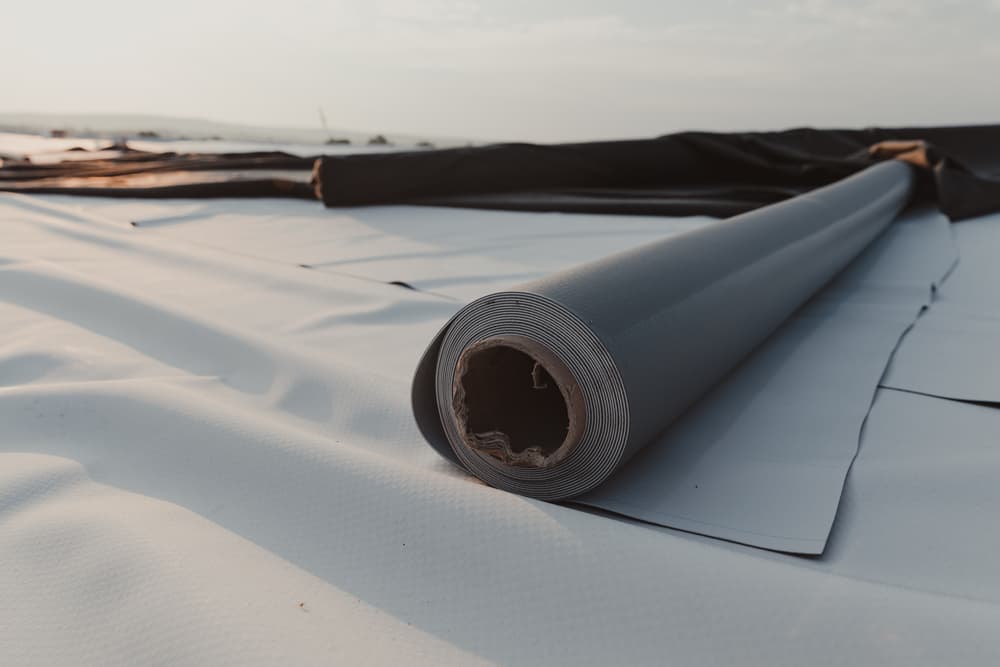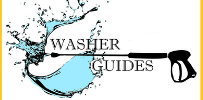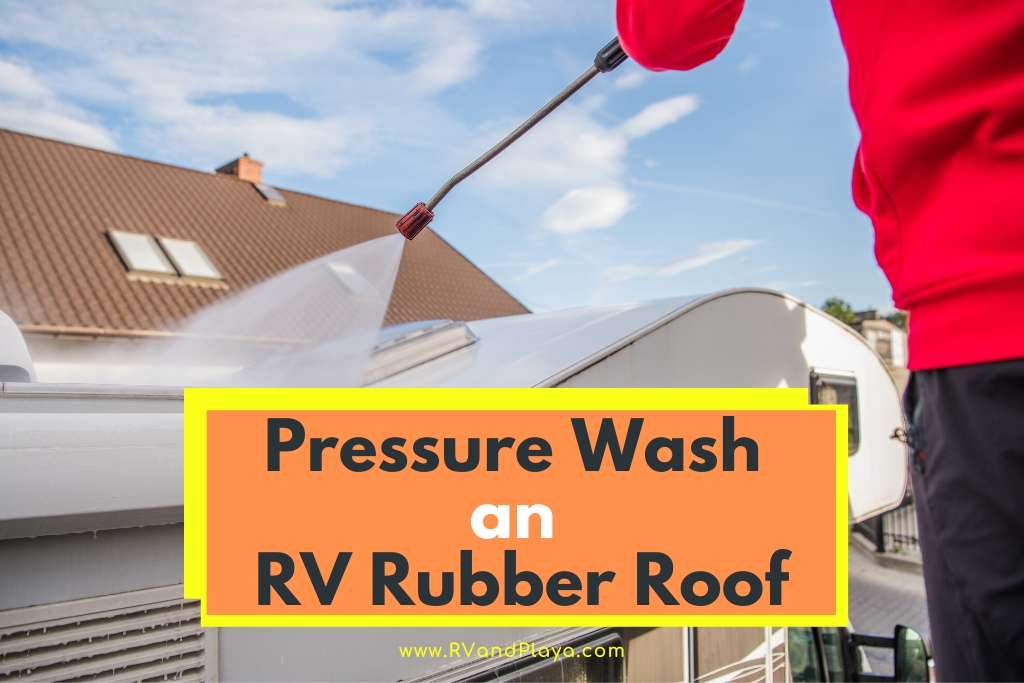If you have a recreational vehicle (RV) with a rubber roof, you may be wondering if it’s possible to pressure wash it. The answer is yes, but there are some things you need to keep in mind to avoid damaging your roof. Here are some tips for pressure washing your RV rubber roof.
- Buy or rent a pressure washer
- Make sure it has enough power to blast away dirt and grime from your RV’s rubber roof
- Set up the pressure washer according to the manufacturer’s instructions
- Place the machine on firm, level ground, and connect the hose to a water source
- Put on safety glasses and gloves to protect yourself from debris that could be hurled by the pressure washer
- Aim the nozzle of the pressure washer at the RV rubber roof, and start washing from one end of the roof to the other in a back-and-forth motion
- Overlap each pass so you don’t miss any spots
- Rinse off all soap residue with clean water from a garden hose when you’re finished pressure washing the roof
- Let the RV rubber roof dry completely before walking on it or applying any sealants or coatings
How to Wash an Rv With a Pressure Washer?
If you’ve never washed an RV with a pressure washer before, don’t worry – it’s not as difficult as it may seem! Just follow these simple steps and you’ll have your RV looking sparkling clean in no time.
1. Fill up your pressure washer with water and detergent. You can use any type of detergent – just make sure it’s designed for use with a pressure washer.
2. Start at the top of your RV and work your way down, using the pressure washer to blast away any dirt or grime. Be careful not to hold the nozzle too close to the surface, or you could damage the paintwork.
3. Once you’ve finished washing the main body of the RV, move on to cleaning the wheels and tires. This is where a lot of dirt and grime can build up, so it’s important to give them a good clean too.
4. Rinse off all of the detergent with clean water from your pressure washer, then dry your RV off with a soft cloth or towel.
And that’s it! Now you know how to wash an RV with a pressure washer like a pro!
Rv Roof Cleaner
If you have an RV, then you know how important it is to keep the roof clean. Not only does it make the RV look nicer, but it also helps extend the life of the roof. Routine cleaning and maintenance will help prevent leaks and other problems that can occur if the roof isn’t properly cared for.
There are a few different ways that you can clean your RV roof, but one of the best is to use an RV roof cleaner. These cleaners are specifically designed to clean and protect your RV’s roof, and they can be found at most auto or RV stores. Simply apply the cleaner to the roof according to the directions and then rinse it off with a hose.
You’ll want to do this at least once a year – more often if you live in an area with lots of trees or other debris that could fall on your RV’s roof.
In addition to using an RV roof cleaner, you should also inspect your Roofing System yearly for any cracks or leaks that may have developed. If you find any damage, be sure to have it repaired as soon as possible by a qualified professional.
By taking these simple steps, you can help ensure that your RV’s roof will last for many years to come!
Washing a Rv
If you’ve never washed an RV before, the prospect can be a little daunting. But don’t worry – with a little planning and elbow grease, you can get your rig sparkling clean in no time! Here’s what you need to know about washing an RV:
First, gather your supplies. You’ll need a mild soap (dish soap is usually fine), a soft brush or sponge, and plenty of water. A hose with a sprayer attachment will make things easier, but you can also use buckets of water if necessary.
Start by giving your RV a good once-over with the hose, spraying off any loose dirt or debris. Then, working from top to bottom, start scrubbing down the outside of the RV with your soap and brush. Rinse everything off well as you go.
Once the outside is clean, move on to the inside. Again, start at the top and work your way down, cleaning surfaces with soapy water and rinsing them afterwards. Don’t forget to vacuum and shampoo any carpets or upholstery as well!
When you’re finished cleaning, give everything another rinse with the hose to remove any leftover soap residue. Then dry everything off – it’s best to do this in direct sunlight if possible. And that’s it – your RV should now be sparkling clean!
Best Way to Remove Rv Cover
If you’ve ever had an RV, you know how important it is to keep it clean and well-maintained. One of the best ways to do this is to remove the RV cover every so often and give it a good cleaning. Here are some tips on the best way to remove your RV cover:
1. Make sure that you have all the right tools. You’ll need a ladder, a brush or broom, and a hose with a spray nozzle attachment.
2. Park your RV in an area where you can easily access all sides of it.
This will make it easier to reach every nook and cranny when you’re cleaning.
3. Start by using the brush or broom to sweep off any loose debris from the top of the RV cover. Then, climb up the ladder and begin hosing down the cover, working from top to bottom.
4. Once you’ve given the entire cover a good rinse, use your brush or broom to scrub away any stubborn dirt or grime. Rinse again if necessary.
5. Finally, lower the ladder and step back to admire your handiwork!
Your RV will look good as new in no time thanks to your efforts in giving it a thorough cleaning – including removing its cover!
Diy Rv Gutter Extensions
If you have an RV, you know that one of the most annoying things about them is cleaning the gutters. It’s a necessary evil, however, if you want to keep your RV in good shape and prevent water damage. But there’s an easy way to make this chore a little less tedious: DIY RV gutter extensions!
Extensions simply attach to your existing gutters and extend them out beyond the edge of your roof. This way, when rain or melting snow runs down your roof, it will be caught by the extension and directed away from your RV. No more water running down the sides of your rig and into those pesky nooks and crannies!
Installing gutter extensions is a fairly simple process that any DIY-er can handle. Just follow these steps:
1. Measure the length of your RV’s gutters and cut your extensions to size.
You’ll want them to be slightly longer than the gutters so that they overlap at the seams.
2. Use heavy-duty zip ties or screws to attach the extensions to the gutters. Make sure they’re secure so that they don’t blow off in high winds!
3. That’s it! Now just sit back and enjoy not having to clean out those pesky gutters every time it rains (or snows).

Credit: roofmaster.ca
What is the Best Way to Clean an Rv Rubber Roof?
If you have an RV with a rubber roof, you know that it can be a pain to keep clean. Rubber roofs are prone to mildew and mold, and they can be difficult to clean without damaging the material. Here are some tips on how to clean your RV’s rubber roof without causing any damage:
-Start by mixing equal parts water and white vinegar in a bucket.
-Dip a soft bristle brush into the mixture and scrub the entire surface of the roof. Pay special attention to areas that seem dirty or discolored.
-Rinse the roof off with a garden hose, making sure to remove all of the cleaning solution.
-Once the roof is dry, apply a thin layer of RV rubber roof sealant. This will help protect the roof from future dirt and grime buildup.
Can You Pressure Wash an Epdm Roof?
Yes, you can pressure wash an EPDM roof. However, there are a few things to keep in mind when doing so. First, use only a moderate amount of pressure when washing the roof.
Too much pressure can damage the EPDM material. Second, be sure to use a gentle detergent when cleaning the roof. Harsh chemicals can also damage the EPDM material.
Is It Ok to Pressure Wash an Rv?
It is perfectly fine to pressure wash your RV as long as you take the proper precautions. The first step is to make sure that you have all of the right materials and equipment. You will need a pressure washer, a garden hose, some soap, and a brush.
Once you have gathered all of your materials, it is time to start washing.
The best way to pressure wash your RV is to start from the top and work your way down. This will prevent any water from seeping into cracks or crevices and causing damage.
Begin by spraying the entire RV with water from the pressure washer on its lowest setting. Next, apply some soap to a small area and scrub with the brush. Finally, turn up the pressure washer to its highest setting and rinse off the suds.
If you take these simple steps, you can safely and effectively pressure wash your RV without worry!
What Do You Clean a Camper Rubber Roof With?
Assuming you are asking about cleaning the roof of a Recreational Vehicle (RV) or “camper” as they are often called:
There are a number of products on the market specifically for cleaning RV roofs. One popular option is Dicor’s Roof Cleaner & Conditioner.
Another is Camco’s RV Rubber Roof Cleaner.
To use either of these products, simply spray them on the roof and then scrub with a brush. Rinse well with water afterwards.
These cleaners can be used on both rubber and fiberglass RV roofs.
If you don’t have either of these products on hand, you can also use dish soap and water to clean your RV roof. Simply mix up a solution of warm water and dish soap, apply it to the roof, and scrub with a brush.
Rinse well afterwards.
Cleaning a Very Dirty RV Rubber Roof Membrane
Conclusion
If you have a rubber roof on your RV, you may be wondering if it’s okay to pressure wash it. The answer is yes, you can pressure wash a rubber roof, but there are a few things you need to keep in mind. First of all, make sure that the pressure washer you’re using is set to a low setting.
You don’t want to damage the roof by using too much pressure. Second, use a mild soap or cleaning solution when washing the roof. You don’t want to use anything harsh that could damage the roofing material.
Finally, make sure that you rinse the roof thoroughly after washing it so that no soap residue is left behind.

